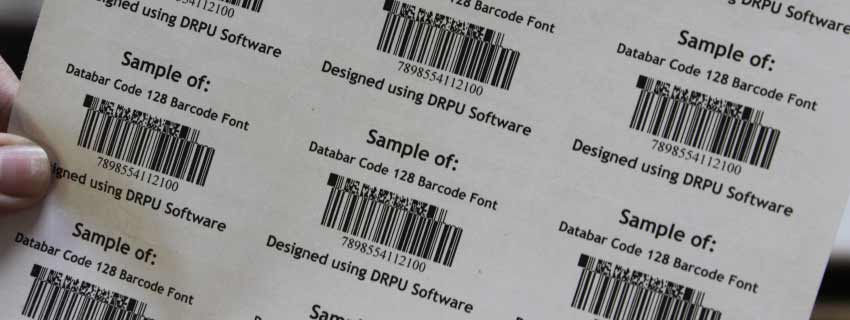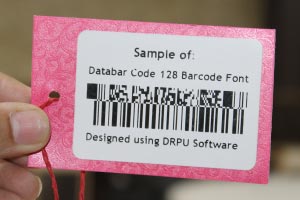Structure of a Databar Code 128 Barcode
The barcode is composed of several elements, including the start code, data characters, check digit, and stop code. Each of these elements serves a specific purpose and is essential for the accurate decoding of the barcode data.
-
Start Code
The start code is a fixed pattern of bars and spaces that indicates the beginning of the barcode. The start code for DataBar Code 128 barcode is a combination of three bars and three spaces, with a ratio of 1:1:1:1:1:1.
The start code is necessary to signal to the barcode reader where the barcode begins and to distinguish it from other barcodes or markings on the product.
-
Data Characters
The data characters are the encoded data that represent the information stored in the barcode. The DataBar Code 128 barcode can encode both numeric and alphanumeric characters, as well as special characters such as punctuation marks and symbols.
The data characters are divided into three different subsets, known as Code 128 A, Code 128 B, and Code 128 C. Each subset encodes a different range of characters and uses a different encoding method.
Code 128 A encodes uppercase letters, digits, and control characters. Code 128 B encodes uppercase and lowercase letters, digits, and some special characters. Code 128 C encodes digits only, but it does so using pairs of digits, effectively doubling the number of characters that can be encoded.
The choice of which subset to use depends on the type of data being encoded and the available space on the product.
-
Check Digit
The check digit is a mathematical formula that is used to verify the accuracy of the barcode data. It is calculated based on the values of the data characters and is included in the barcode to ensure that it is read correctly.
The check digit is calculated using a specific algorithm, which varies depending on the subset of Code 128 being used. The algorithm is designed to produce a single-digit check digit that is added to the end of the barcode.
The check digit allows the barcode reader to detect and correct errors in the barcode data. If the calculated check digit does not match the check digit included in the barcode, the barcode reader knows that an error has occurred and can attempt to correct it.
-
Stop Code
The stop code is a fixed pattern of bars and spaces that indicates the end of the barcode. The stop code for DataBar Code 128 barcode is a combination of three bars and three spaces, with a ratio of 1:1:1:1:1:1.
The stop code is necessary to signal to the barcode reader where the barcode ends and to distinguish it from other barcodes or markings on the specific product or item.
-
Quiet Zone
The quiet zone is a clear area of a specified width that surrounds the barcode on all sides. The quiet zone is necessary to ensure that the barcode can be read accurately and reliably.
The quiet zone must be free of any markings or printed material and must be of a sufficient size to allow the barcode reader to distinguish between the barcode and the surrounding area.
The DataBar Code 128 barcode is a linear, one-dimensional barcode that consists of a series of bars and spaces of varying widths. The barcode is read from left to right, with each bar and space representing a binary code that corresponds to a character or group of characters.
The barcode is composed of several elements, including the start code, data characters, check digit, stop code, and quiet zone.
Minimum and Maximum Size of a Databar Code 128 Barcode
DataBar Code 128 barcode is a linear barcode that is commonly used in retail and healthcare industries. One of the important factors to consider when creating a DataBar Code 128 barcode is the size of the barcode itself.

The size of a DataBar Code 128 barcode depends on several factors, including the amount of data being encoded, the printing method, and the scanning equipment being used. In this article, we will discuss the minimum and maximum size of a DataBar Code 128 barcode and the factors that influence barcode size.
-
Minimum Size
The minimum size of a DataBar Code 128 barcode depends on the printing method being used. If the barcode is being printed using direct thermal or thermal transfer printing, the minimum width of the narrowest bar should be at least 0.010 inches or 0.254 mm. If the barcode is being printed using inkjet or laser printing, the minimum width of the narrowest bar should be at least 0.007 inches or 0.178 mm.
The minimum height of a DataBar Code 128 barcode is typically set at 0.5 inches or 12.7 mm. This height ensures that the barcode is easily readable by barcode scanners.
It is important to note that the minimum size of a DataBar Code 128 barcode may vary depending on the amount of data being encoded. If the barcode is encoding a large amount of data, the minimum size may need to be increased to ensure that the barcode is readable.
-
Maximum Size
The maximum size of a DataBar Code 128 barcode depends on the size of the label or item that the barcode is being applied to. The barcode should be sized so that it fits comfortably on the label or item without crowding or overlapping other elements.
In addition to the size of the label or item, the maximum size of a DataBar Code 128 barcode also depends on the scanning equipment being used. Some barcode scanners may have difficulty reading barcodes that are too large, especially if the scanner has a limited depth of field.
The maximum size of a DataBar Code 128 barcode is typically set at 4 inches or 101.6 mm in width and 1.5 inches or 38.1 mm in height. This size ensures that the barcode is large enough to be easily readable by barcode scanners while still fitting comfortably on most labels and items.
There are several factors that influence the size of a DataBar Code 128 barcode, including:
-
Amount of Data Being Encoded
The amount of data being encoded in the barcode can have a significant impact on the size of the barcode. If the barcode is encoding a large amount of data, the size of the barcode may need to be increased to ensure that all of the data is readable.
-
Printing Method
The printing method being used can also influence the size of the barcode. Direct thermal and thermal transfer printing methods typically require a larger minimum size for the narrowest bar, while inkjet and laser printing methods can produce smaller barcodes.
-
Label or Item Size
The size of the label or item that the barcode is being applied to can also influence the size of the barcode. The barcode should be sized so that it fits comfortably on the label or item without crowding or overlapping other elements.
-
Scanning Equipment
The scanning equipment being used can also influence the size of the barcode. Some barcode scanners may have difficulty in reading the barcodes that are too small or too large in size, especially if the scanner has a limited depth of field.
The minimum and maximum size of a DataBar Code 128 barcode depends on several factors, including the amount of data being encoded, the printing method, the label or item size, and the scanning equipment being used.
Information Encoded in a Databar Code 128 Barcode
DataBar Code 128 is a linear barcode that is commonly used in retail and healthcare industries. It is a type of GS1 DataBar, which is a family of barcodes that can encode a variety of information. In this article, we will discuss the information that can be encoded in a DataBar Code 128 barcode.
The process of reading and decoding an EAN-13 barcode can be broken down into several steps:
Before discussing the information that can be encoded in a DataBar Code 128 barcode, it is important to understand its basic structure. A DataBar Code 128 barcode consists of a series of bars and spaces that represent data. The barcode includes start and stop characters, which indicate the beginning and end of the barcode, as well as a check character, which is used to ensure data accuracy.
In addition to the start and stop characters, a DataBar Code 128 barcode can include a variety of data elements, including:
An AI is a two or three digit number that indicates the meaning and format of the data that follows. For example, AI (01) indicates that the data that follows is a Global Trade Item Number (GTIN).
The data that follows the AI is the actual information that is being encoded in the barcode.
Some AIs allow for optional data to be included in the barcode. This data is not required, but can provide additional information about the product.
A DataBar Code 128 barcode can encode a variety of information, including product identification, expiration dates, lot numbers, and serial numbers. The specific information that is encoded in the barcode depends on the application and industry.
-
Product Identification
One of the most common uses of DataBar Code 128 barcode is to encode product identification information. This information is typically a Global Trade Item Number (GTIN), which is a unique identifier assigned to a product by the manufacturer. The GTIN can be 8, 12, 13, or 14 digits in length, depending on the format being used. In addition to the GTIN, a DataBar Code 128 barcode can also encode other product identification information, such as the brand name, product description, and packaging type.
-
Expiration Dates
DataBar Code 128 barcode can also encode expiration dates, which are used to ensure that products are consumed or used before they expire. The expiration date can be encoded in a variety of formats, including year-month-day (YYYYMMDD), year-month (YYYYMM), or month-day (MMDD).
-
Lot Numbers
Lot numbers are used to identify a specific batch of a product. They are commonly used in industries such as pharmaceuticals and food manufacturing. A DataBar Code 128 barcode can encode lot numbers in a variety of formats, including numeric, alphanumeric, and date-based formats.
-
Serial Numbers
A DataBar Code 128 barcode can also encode serial numbers, which are used to identify a specific unit of a product. Serial numbers can be numeric or alphanumeric, and are often used in industries such as electronics and automotive manufacturing.
-
Other Information
In addition to the information discussed above, a DataBar Code 128 barcode can also encode other types of information, such as:
✅ Price Information:Some retailers use DataBar Code 128 barcode to encode price information, which can be read by point-of-sale systems.
✅ Customer information:DataBar Code 128 barcode can be used to encode customer information, such as loyalty program membership numbers or customer account numbers.
✅ Prescription information:In the healthcare industry, DataBar Code 128 barcode can be used to encode prescription information, such as the patient's name and medication dosage.